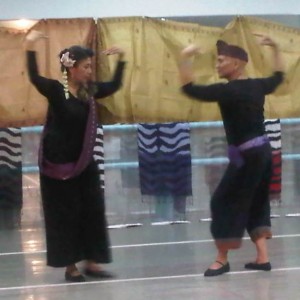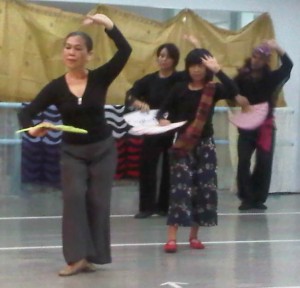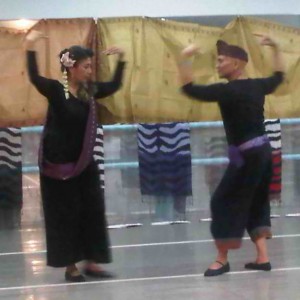By ELIZABETH LOLARGA
 SO exciting is this rediscovered dance form pangalay, which translates to “a gift offering,” that it is being performed to songs interpreted by Josh Groban, Jacqui Magno, the inimitable Sylvia la Torre, among others.
SO exciting is this rediscovered dance form pangalay, which translates to “a gift offering,” that it is being performed to songs interpreted by Josh Groban, Jacqui Magno, the inimitable Sylvia la Torre, among others.
The ancient pangalay came before Islam and Christianity and involves the use of downcast eyes, fluid arm movements, flexing of hands, bent knees and deceptively easy-looking, mincing footsteps.
Purists may balk at why pangalay, as choreographed and danced by members of Ligaya Amilbangsa’s AlunAlun Dance Circle (ADC), is not sustained by the percussive beat alone of the kulintang.
One of ADC’s missions is to show that the basic movement of pangalay can adapt to pop music hits like Ennio Morricone’s composition “You’re Still You” or a mambo take-off from Mozart’s “Symphony No. 40.”
At a performance of new choreographic works at the University of the Philippines Dance Studio in Diliman, Quezon City, the ADC showed how versatile pangalay could be–how it could be danced to indigenous and Western music. This proved its openness to possibilities while its form is still conserved.
In the old days, pangalay was a ritual dance or form of prayer seen at weddings, birthdays or whenever special guests visit. Sometimes, it was danced to drive malevolent spirits away.
Prof. Steve Villaruz said in his introduction it is a pity pangalay is not seen often, has been neglected or almost forgotten as it is too far south of the archipelago. He traced the public’s ignorance to perhaps “a bias against fellow Asians” since pangalay has movements similar to other classical styles of Asian dances in Indonesia, Cambodia and Thailand.
ADC dancer-managing director Nanette Matilac demonstrated pangalay‘s link to Asian theater and martial art forms like the Noh, tai chi and aikido where “breathing is the key to hours of dancing.”
Emcee CB Garrucho, also an ADC member, recalled the moment when she and others first saw Amilbangsa dance and felt as though they were “hit between the eyes.” The dancing had such an impact on their souls that they sought out the dancer-scholar. They learned that pangalay is almost dying with three-fourths of the country unaware of it.
As the group grew, the ADC was formed to keep it alive with dance classes held each Sunday at 35 Sampaguita St., Lopezville Subdivision, Masinag, Antipolo City.
Amilbangsa said, “Pangalay has to be danced constantly, or else it dies. It is a piece of our identity that speaks beautifully of us as a people. It’s our living link to our Asian heritage.”
 While doing research in the Sulu archipelago, she once saw a hunched, raggedly dressed woman by the road. The minute the kulintang was struck and began its hypnotic beat, the woman transformed into a queenly figure as she went through the pangalay steps.
While doing research in the Sulu archipelago, she once saw a hunched, raggedly dressed woman by the road. The minute the kulintang was struck and began its hypnotic beat, the woman transformed into a queenly figure as she went through the pangalay steps.
Amilbangsa encouraged more dance students to try the movements, which she likened to “motion in stillness, stillness in motion.”
“It’s very relaxed and quiet,” she said. “It’s in your bones. Hindi niyo lang ginagamit (You just don’t use it).”
The male and female dancers were garbed in all-black outfits and soft ballet slippers, all the more to outline and define their movements against a stark backdrop of shrouded dance mirrors. There were accents of flowers behind the ears, twinkling earrings and sashes for the ladies, head gear and sometimes janggay (metal claws) for the men.
Pangalay‘s striking feature is its capacity to accommodate a vast age range. There was a girl, Gemely C. Amar, not quite out of her teens, dancers in their prime like Raymund Marcaida, women in their 50s and 60s. And then there’s Amilbangsa herself whose supple low bend on a single knee while dancing behind a mask to “Mambozart” by the Klazz Brothers and Cuba Percussion belied her age of 67.
ADC must also be commended for its eclectic choice of music. It gives a respectful bow to National Artists Nicanor Abelardo (“Bituing Marikit”) and Levi Celerio (“Basta’t Mahal Kita”), to Nitoy Gonzales’ haunting “Usahay,” which Matilac choreographed and danced, turning herself just by suggestive movements into a young woman once more, holding close through her daydreams her secret love. Rimsky-Korsakov’s “Flight of the Bumble Bee” punctuated Matilac’s busy bee eluding capture by hunter Kevin Lumbao, an aikido player.
Constancio de Guzman’s “Ang Tangi Kong Pag-ibig,” sung by Marco Sison, had Francisco and Marcaida moving in mirror image like a mature couple attuned to each other’s reflexes that each movement is almost predictable.
The ardor is again suggested as pangalay speaks in “emotional metaphors,” Amilbangsa said. An outstretched hand, for example, could be a salutation of welcome or joy.
For 2011, ADC is lining up performances in schools, especially during the arts month in February. Matilac said they want to show pangalay to the youth to give a practical expression of being Filipino as against, on one hand, Christianized/Hispanized folk dances and on the other, Western dances from ballet to jazz to hip-hop.
During the open forum at UP, a student who had learned pangalay under Matilac said she was happy to discover it after training in ballet and jazz. She said it made her feel more Filipino.
“Hinding-hindi ko po ito bibitiwan (I won’t ever let go of this),” she said.
